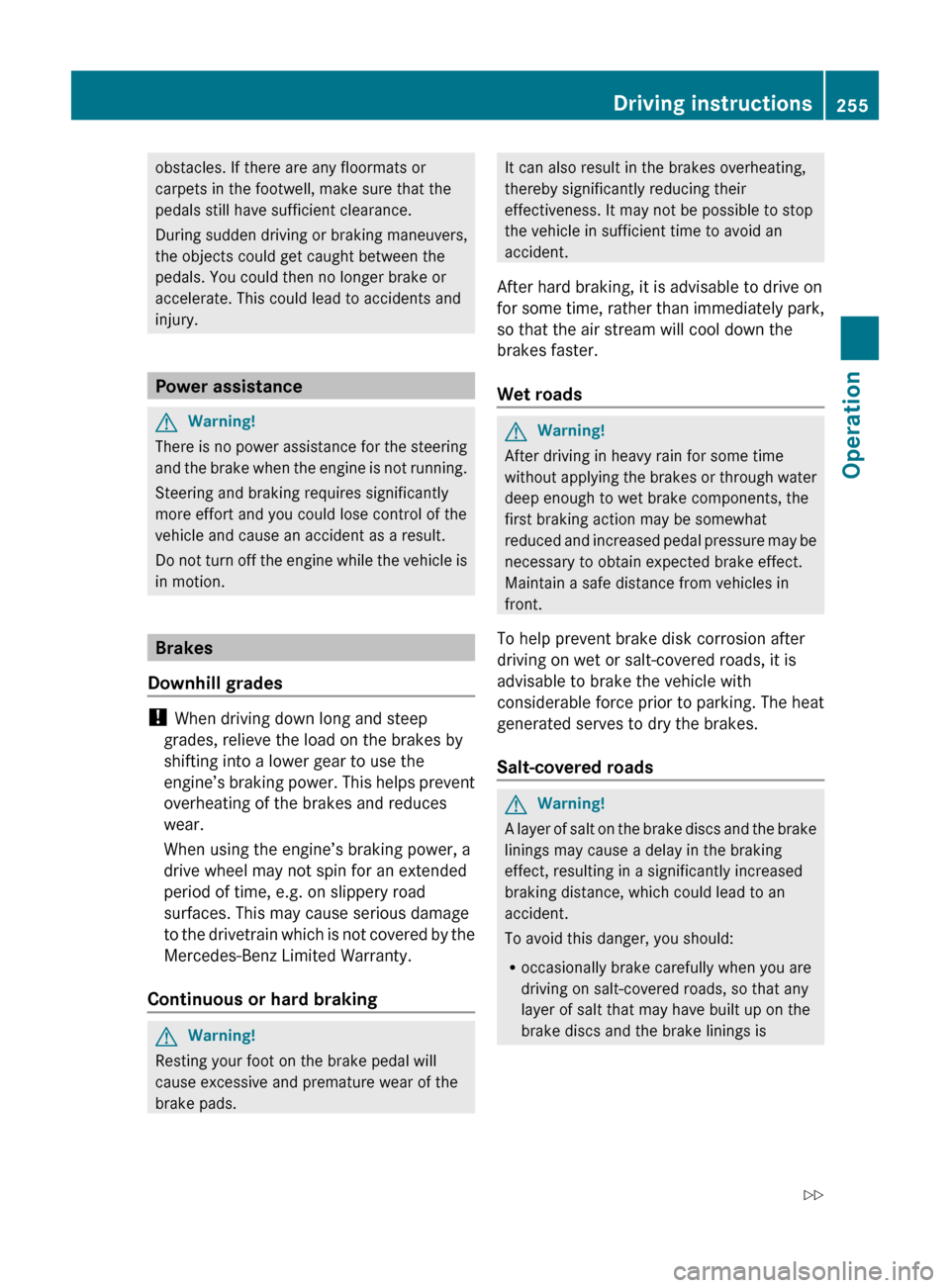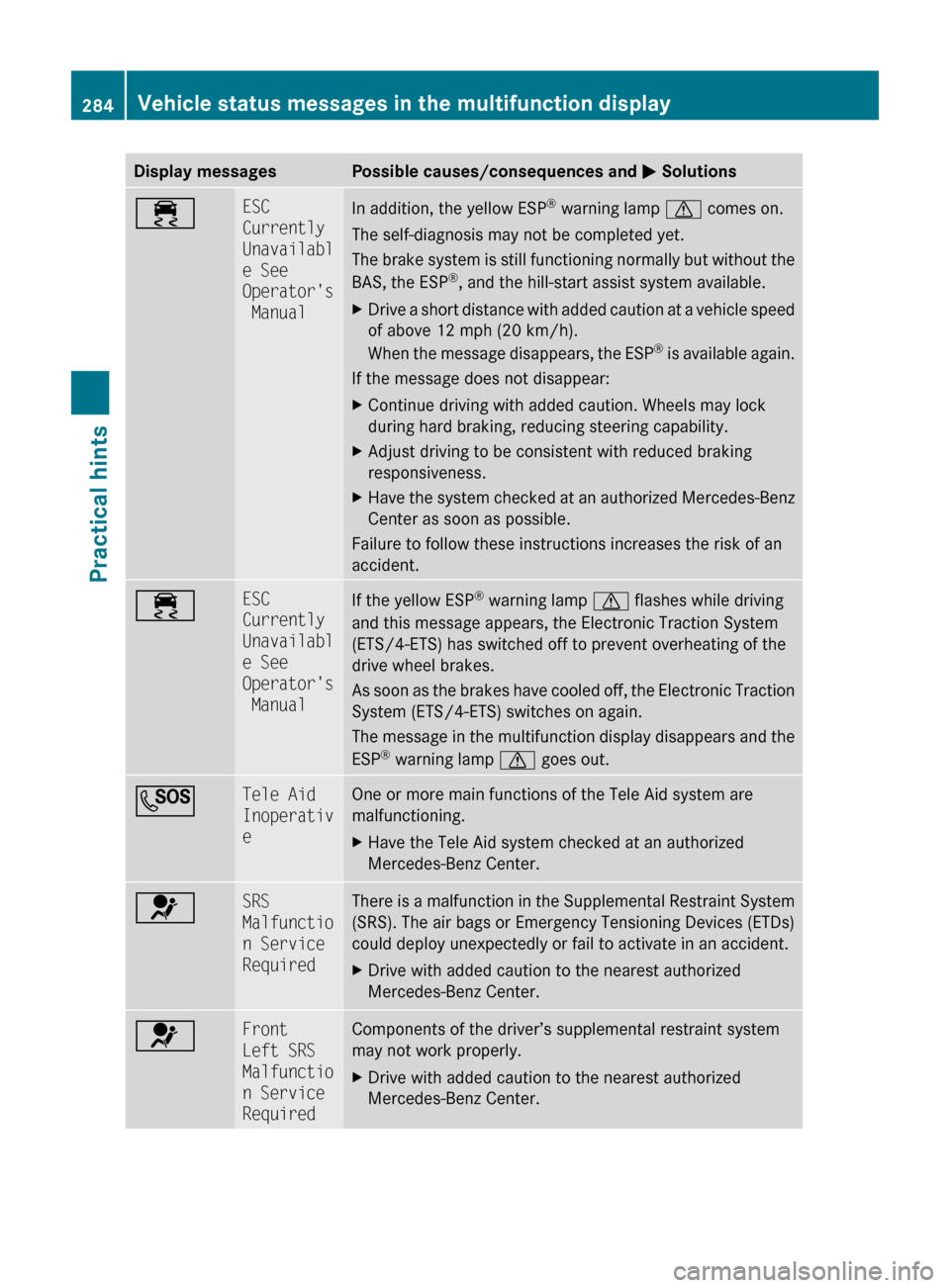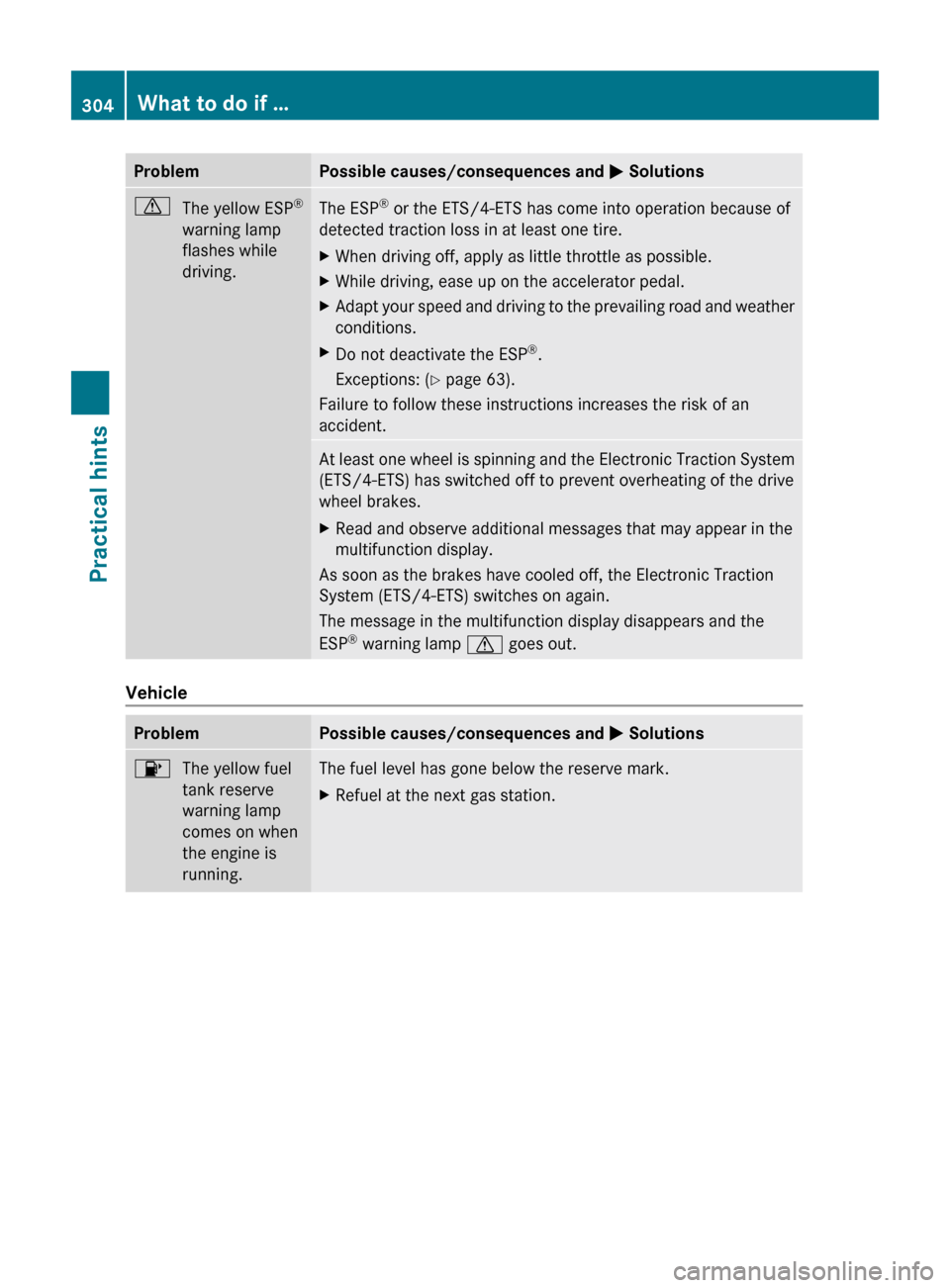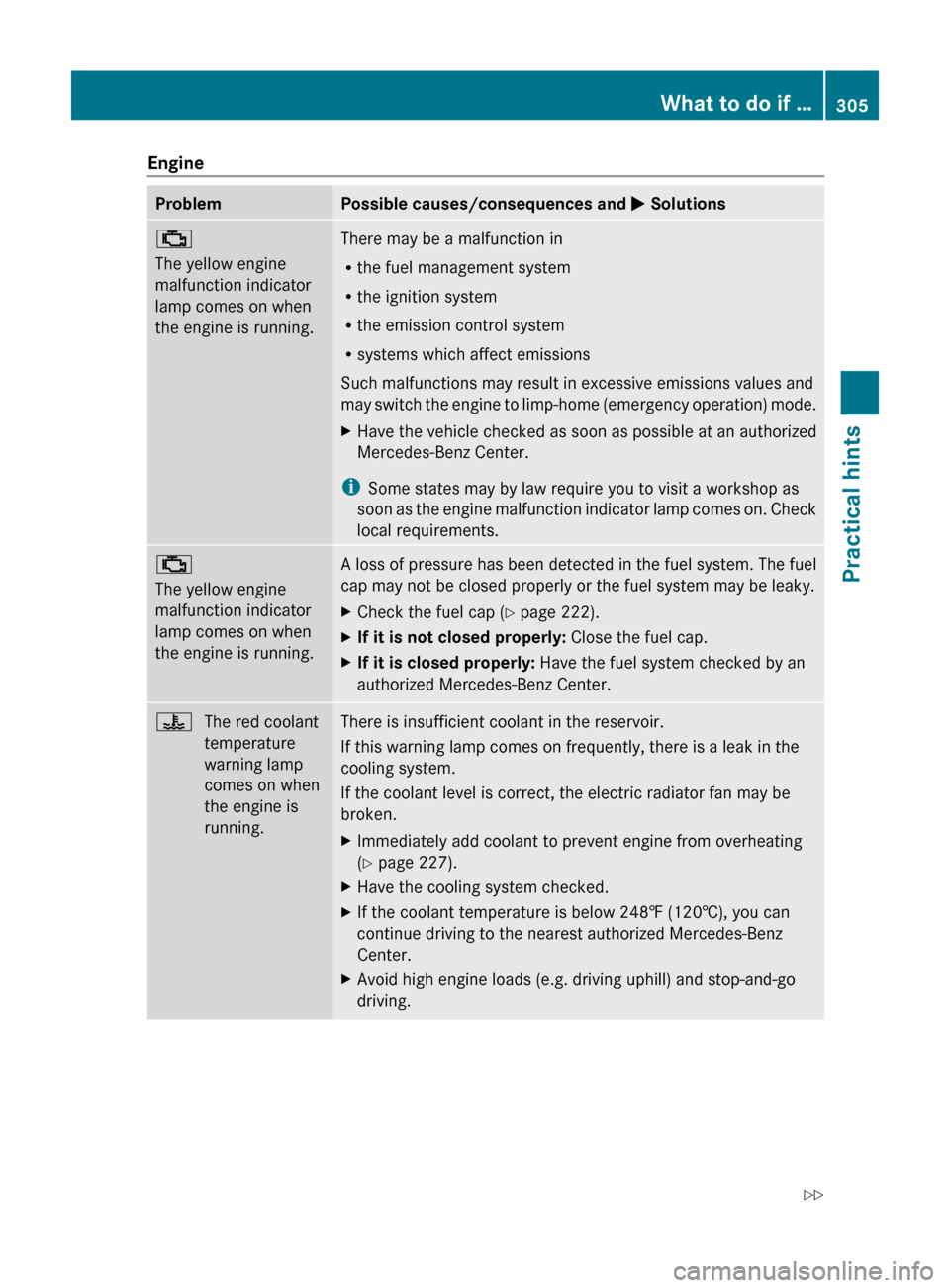2010 MERCEDES-BENZ C300 4MATIC overheating
[x] Cancel search: overheatingPage 257 of 364

obstacles. If there are any floormats or
carpets in the footwell, make sure that the
pedals still have sufficient clearance.
During sudden driving or braking maneuvers,
the objects could get caught between the
pedals. You could then no longer brake or
accelerate. This could lead to accidents and
injury.
Power assistance
GWarning!
There is no power assistance for the steering
and the brake when the engine is not running.
Steering and braking requires significantly
more effort and you could lose control of the
vehicle and cause an accident as a result.
Do not turn off the engine while the vehicle is
in motion.
Brakes
Downhill grades
! When driving down long and steep
grades, relieve the load on the brakes by
shifting into a lower gear to use the
engine’s braking power. This helps prevent
overheating of the brakes and reduces
wear.
When using the engine’s braking power, a
drive wheel may not spin for an extended
period of time, e.g. on slippery road
surfaces. This may cause serious damage
to the drivetrain which is not covered by the
Mercedes-Benz Limited Warranty.
Continuous or hard braking
GWarning!
Resting your foot on the brake pedal will
cause excessive and premature wear of the
brake pads.
It can also result in the brakes overheating,
thereby significantly reducing their
effectiveness. It may not be possible to stop
the vehicle in sufficient time to avoid an
accident.
After hard braking, it is advisable to drive on
for some time, rather than immediately park,
so that the air stream will cool down the
brakes faster.
Wet roadsGWarning!
After driving in heavy rain for some time
without applying the brakes or through water
deep enough to wet brake components, the
first braking action may be somewhat
reduced and increased pedal pressure may be
necessary to obtain expected brake effect.
Maintain a safe distance from vehicles in
front.
To help prevent brake disk corrosion after
driving on wet or salt-covered roads, it is
advisable to brake the vehicle with
considerable force prior to parking. The heat
generated serves to dry the brakes.
Salt-covered roads
GWarning!
A layer of salt on the brake discs and the brake
linings may cause a delay in the braking
effect, resulting in a significantly increased
braking distance, which could lead to an
accident.
To avoid this danger, you should:
R occasionally brake carefully when you are
driving on salt-covered roads, so that any
layer of salt that may have built up on the
brake discs and the brake linings is
Driving instructions255Operation204_AKB; 5; 23, en-USd2ureepe,Version: 2.11.8.12009-07-16T17:54:06+02:00 - Seite 255Z
Page 286 of 364

Display messagesPossible causes/consequences and M Solutions÷ESC
Currently
Unavailabl
e See
Operator's
ManualIn addition, the yellow ESP ®
warning lamp d comes on.
The self-diagnosis may not be completed yet.
The brake system is still functioning normally but without the
BAS, the ESP ®
, and the hill-start assist system available.XDrive a short distance with added caution at a vehicle speed
of above 12 mph (20 km/h).
When the message disappears, the ESP ®
is available again.
If the message does not disappear:
XContinue driving with added caution. Wheels may lock
during hard braking, reducing steering capability.XAdjust driving to be consistent with reduced braking
responsiveness.XHave the system checked at an authorized Mercedes-Benz
Center as soon as possible.
Failure to follow these instructions increases the risk of an
accident.
÷ESC
Currently
Unavailabl
e See
Operator's
ManualIf the yellow ESP ®
warning lamp d flashes while driving
and this message appears, the Electronic Traction System
(ETS/4-ETS) has switched off to prevent overheating of the
drive wheel brakes.
As soon as the brakes have cooled off, the Electronic Traction
System (ETS/4-ETS) switches on again.
The message in the multifunction display disappears and the
ESP ®
warning lamp d goes out.GTele Aid
Inoperativ
eOne or more main functions of the Tele Aid system are
malfunctioning.XHave the Tele Aid system checked at an authorized
Mercedes-Benz Center.6SRS
Malfunctio
n Service
RequiredThere is a malfunction in the Supplemental Restraint System
(SRS). The air bags or Emergency Tensioning Devices (ETDs)
could deploy unexpectedly or fail to activate in an accident.XDrive with added caution to the nearest authorized
Mercedes-Benz Center.6Front
Left SRS
Malfunctio
n Service
RequiredComponents of the driver’s supplemental restraint system
may not work properly.XDrive with added caution to the nearest authorized
Mercedes-Benz Center.284Vehicle status messages in the multifunction displayPractical hints
204_AKB; 5; 23, en-USd2ureepe,Version: 2.11.8.12009-07-16T17:54:06+02:00 - Seite 284
Page 306 of 364

ProblemPossible causes/consequences and M SolutionsdThe yellow ESP ®
warning lamp
flashes while
driving.The ESP ®
or the ETS/4-ETS has come into operation because of
detected traction loss in at least one tire.XWhen driving off, apply as little throttle as possible.XWhile driving, ease up on the accelerator pedal.XAdapt your speed and driving to the prevailing road and weather
conditions.XDo not deactivate the ESP ®
.
Exceptions: ( Y page 63).
Failure to follow these instructions increases the risk of an
accident.
At least one wheel is spinning and the Electronic Traction System
(ETS/4-ETS) has switched off to prevent overheating of the drive
wheel brakes.XRead and observe additional messages that may appear in the
multifunction display.
As soon as the brakes have cooled off, the Electronic Traction
System (ETS/4-ETS) switches on again.
The message in the multifunction display disappears and the
ESP ®
warning lamp d goes out.
Vehicle
ProblemPossible causes/consequences and M Solutions8The yellow fuel
tank reserve
warning lamp
comes on when
the engine is
running.The fuel level has gone below the reserve mark.XRefuel at the next gas station.304What to do if …Practical hints
204_AKB; 5; 23, en-USd2ureepe,Version: 2.11.8.12009-07-16T17:54:06+02:00 - Seite 304
Page 307 of 364

EngineProblemPossible causes/consequences and M Solutions;
The yellow engine
malfunction indicator
lamp comes on when
the engine is running.There may be a malfunction in
R the fuel management system
R the ignition system
R the emission control system
R systems which affect emissions
Such malfunctions may result in excessive emissions values and
may switch the engine to limp-home (emergency operation) mode.XHave the vehicle checked as soon as possible at an authorized
Mercedes-Benz Center.
i Some states may by law require you to visit a workshop as
soon as the engine malfunction indicator lamp comes on. Check
local requirements.
;
The yellow engine
malfunction indicator
lamp comes on when
the engine is running.A loss of pressure has been detected in the fuel system. The fuel
cap may not be closed properly or the fuel system may be leaky.XCheck the fuel cap ( Y page 222).XIf it is not closed properly: Close the fuel cap.XIf it is closed properly: Have the fuel system checked by an
authorized Mercedes-Benz Center.?The red coolant
temperature
warning lamp
comes on when
the engine is
running.There is insufficient coolant in the reservoir.
If this warning lamp comes on frequently, there is a leak in the
cooling system.
If the coolant level is correct, the electric radiator fan may be
broken.XImmediately add coolant to prevent engine from overheating
( Y page 227).XHave the cooling system checked.XIf the coolant temperature is below 248‡ (120†), you can
continue driving to the nearest authorized Mercedes-Benz
Center.XAvoid high engine loads (e.g. driving uphill) and stop-and-go
driving.What to do if …305Practical hints204_AKB; 5; 23, en-USd2ureepe,Version: 2.11.8.12009-07-16T17:54:06+02:00 - Seite 305Z